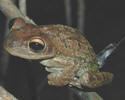Cuban Treefrog Research at UF
Radio Tracking Invasive Cuban Treefrogs
The Cuban Treefrog (Osteopilus septentrionalis) was accidentally brought to Florida in the 1920’s in cargo, and is now established throughout Central and South Florida. This invasive treefrog negatively affects our native wildlife, although the full extent of these effects is unknown. We know very little about the ecology of the Cuban Treefrog -- including how it uses the habitat, and where it takes refuge during the day. This information will be especially important for efforts to control these frogs.
We conducted a pilot study to find out if we could use radiotelemetry (radio tracking) to learn more about the ecology of the Cuban Treefrog. Radiotelemetry has been successfully used to study a variety of terrestrial frogs, but we are still learning how to use this technique to study arboreal (climbing) frogs. In this pilot study, Cuban Treefrogs wearing radio transmitter belts were successfully located under grass and logs, in shrubs, in dense palmetto thickets, and in the treetops. When frogs moved in the treetops, we were able to detect these movements from the ground by triangulation -- taking several readings to pinpoint a location. We also used a 30’ telescoping radio antenna and a spotting scope to sneak a peek at a few frogs hiding in the treetops.
We found that Cuban Treefrogs moved very little during daylight hours, spending most of their time (67%) high above the ground in oak trees. Also, one frog released some distance from where it was caught quickly returned to the capture site -- suggesting that Cuban Treefrogs, like many other amphibians, may be capable of "homing." We still have a lot more to learn about Cuban Treefrogs, but this study shows that radiotelemetry may be a very useful tool for studying these frogs.
McGarrity, M.E. and S.A. Johnson. 2010. A Radio Telemetry Study of Invasive Cuban Treefrogs (574 KB pdf). Florida Scientist 73: 225-235.
![]()

UF Research
- Long-Term Amphibian Monitoring Project
- Impacts of Cuban Treefrog on Native Species
- Cuban Treefrog Deterrent
- Cuban Treefrog Radiotelemetry